Original Author: Mengqi | Editor: Mengqi
1. Bitcoin Market
From March 22 to March 28, 2025, the specific trends of Bitcoin are as follows:
March 22: The Bitcoin market saw a narrowing of volatility, presenting an overall consolidation trend. The price changed little that day, rising slightly from $83,599 to $84,436, with market sentiment remaining relatively stable.
March 23: Bitcoin's price rose from $84,018 to $84,272 in the morning, then fell back to $83,794, briefly dipping below the $84,000 support level before quickly rebounding. In the evening, the market experienced a noticeable surge, with the price breaking through $84,338 and quickly rising to $84,936, ultimately climbing further to $85,302, indicating a significant increase in market activity.
March 24: Bitcoin's price opened with a slight pullback to $84,847 but then continued its upward trend, breaking through key resistance levels and reaching as high as $86,394. Although it briefly retreated to $85,585, bullish sentiment dominated the market, and Bitcoin's price continued to rise, breaking out of the previous consolidation range, ultimately reaching a weekly high of $88,740.
March 25: After consolidating around $88,300, Bitcoin experienced a significant pullback, hitting a low of $86,436. The price then rebounded slightly to $86,844 but failed to hold, adjusting briefly before rising again, ultimately recovering to $88,154, with market performance being quite volatile.
March 26: Bitcoin continued the upward momentum from the previous day, further climbing to $88,447. However, the market then experienced two rounds of pullbacks, with prices dipping to $87,283 and $87,117, respectively. Despite this, Bitcoin quickly rebounded to $88,241. In the evening, market volatility intensified, with the price plunging from $88,241 to $86,598, followed by a slight recovery to around $86,800.
March 27: Bearish forces strengthened in the market, causing Bitcoin's price to break below the key support level of $86,000, hitting a low of $85,929. However, it quickly rebounded to $87,373, and after a brief adjustment, it dipped again to $86,602, ultimately rising to $87,667, with the market showing a pattern of intense fluctuations.
March 28: Bitcoin's price volatility decreased, oscillating between $86,895 and $87,590, maintaining a level above $86,800.
Summary
This week, Bitcoin's overall trend showed an initial upward breakout; however, in the latter half of the week, the forces of bulls and bears clashed multiple times, resulting in market consolidation. In the first half of the week, the market faced pressure, with prices remaining below $84,630 until March 23 and 24, when prices broke through this key range. After successfully breaking the resistance level on the 24th, a short-term pullback and consolidation occurred on the 25th.
As of now, Bitcoin's price is stabilizing around $87,220, with market sentiment gradually becoming more stable. The key focus moving forward will be whether Bitcoin can further break through the current key resistance area; if successful, it may open up space for further upward movement.
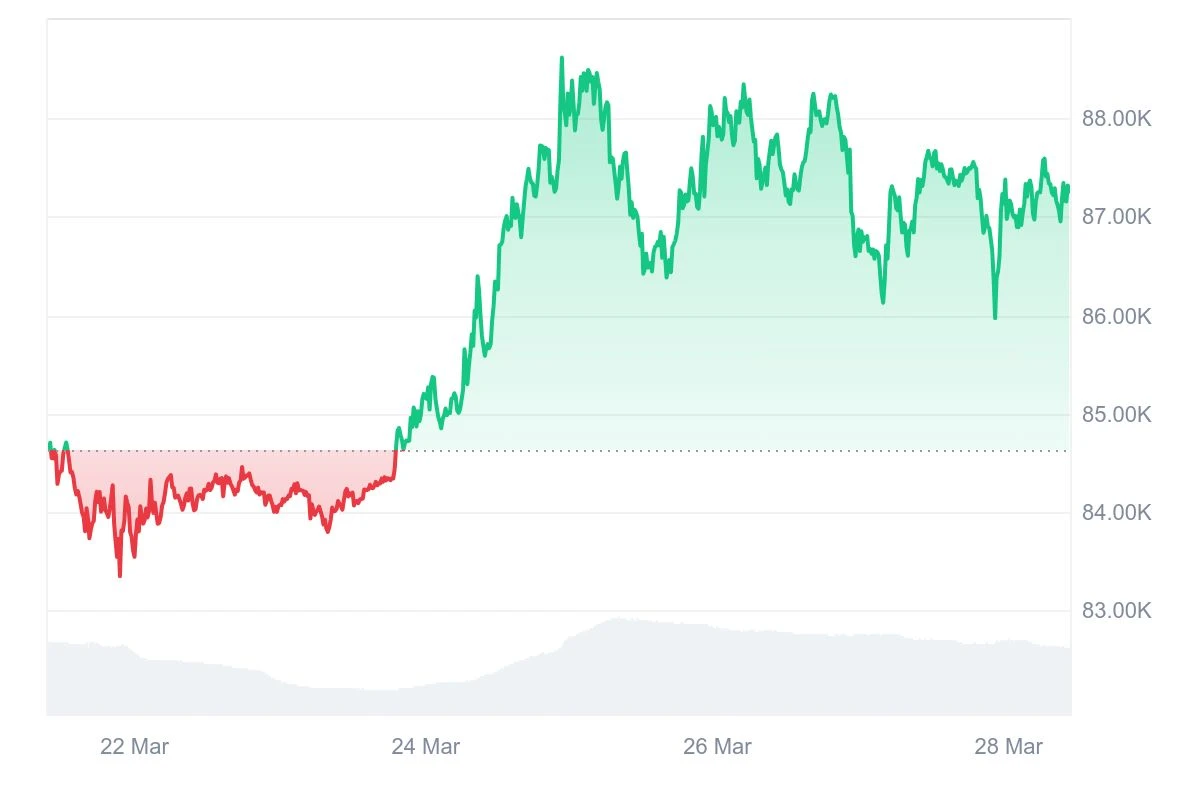
Bitcoin Price Trends (2025/03/22-2025/03/28)
2. Market Dynamics and Macroeconomic Background
Capital Flow
1. Exchange Capital Movement
Bitcoin Spot ETF Capital Flow:
According to SoSoValue data, as of March 28, 2025, the capital flow of Bitcoin spot ETFs showed significant growth. Specifically, on March 27 (Eastern Time), the total net inflow amount for Bitcoin spot ETFs was $89.0638 million, marking ten consecutive days of net inflow in this market.
In terms of specific ETF performance, the Fidelity Bitcoin ETF (FBTC) stood out, with a single-day net inflow of $97.1373 million on March 27, bringing its cumulative historical net inflow to $11.563 billion. Following closely was the BlackRock Bitcoin ETF (IBIT), which had a single-day net inflow of $3.9675 million, with a historical total net inflow of $39.946 billion.
In contrast, the Bitcoin ETF (BTCO) jointly launched by Invesco and Galaxy Digital experienced a net outflow on the same day, with a single-day net outflow of $6.9519 million, and its historical total net inflow currently stands at $98.1845 million.
As of the time of this article's publication, the total net asset value (AUM) of Bitcoin spot ETFs is $98.288 billion, with the net asset ratio (i.e., market cap ratio) at 5.67%. Additionally, the historical cumulative net inflow of this market has reached $36.338 billion.
Exchange Trading Volume Changes:
On March 23, 2025, the trading volume of Bitcoin on Binance exceeded 22,500 BTC, further reflecting a significant increase in market participation. This data indicates that market activity is continuously growing, and investor participation willingness is also on the rise.
2. Institutional and Whale Account Fund Movements
From March 24 to March 25, on-chain data indicated that some institutional funds began to increase their positions, with the number of Bitcoin whales holding between 100 to 10,000 BTC addresses rising from 16,600 to 17,889. This net increase during this phase supported Bitcoin's upward trend.
From March 26 to March 27, some whale accounts began to reduce their holdings, leading to an increase in Bitcoin's inventory on exchanges, indicating a clear trend of short-term profit-taking. This phenomenon aligns with the capital flow in the derivatives market, where bearish forces strengthened, resulting in a significant pullback in Bitcoin's price.
Technical Indicator Analysis
Moving Average (MA): The 50-day moving average (MA50) crossed above the 200-day moving average (MA200) on March 22, forming a "golden cross," which is typically seen as a bullish signal, indicating the potential for a long-term upward trend.
Relative Strength Index (RSI): On March 22, the RSI fell to 50, indicating a balance between bullish and bearish forces, with short-term upward momentum weakening.
Stochastic Indicator: On March 22, the Stochastic indicator showed that the market was in a consolidation state, with short-term upward momentum weakening.
Bollinger Bands: From March 15 to March 25, the Bollinger Bands significantly expanded, with the upper band reaching $90,000 and the lower band at $80,000, reflecting an increase in market volatility.
Trading Volume: On March 23, Bitcoin's trading volume on Binance reached 22,500 BTC, while Ethereum reached 1.2 million ETH on March 24, indicating an increase in market participation.
Market Sentiment
1. Market Sentiment Indicator Analysis
Fear & Greed Index: According to CoinMarketCap data, on March 25, this index rose from 27 in previous days to 34, reflecting that market sentiment had been in a state of fear.
2. Investor Behavior and Market Dynamics
Trading Volume Changes: On March 23, Bitcoin's trading volume on Binance reached 22,500 BTC, indicating an increase in market participation.
Short Position Liquidation: On March 26, when Bitcoin's price reached $87,100, a large number of short positions were liquidated, improving market sentiment as a result.
Macroeconomic Background
From March 22 to March 28, 2025, the rise in Bitcoin's price was supported by the following specific data:
S&P 500 Index Recovery: On March 25, the S&P 500 index rose by 1.7%, breaking above the 200-day moving average (200DMA). This breakthrough provided technical support for market recovery, enhancing the attractiveness of risk assets.
Federal Reserve Rate Expectations: According to CME's "FedWatch," the market expects an 86.4% probability that the Federal Reserve will maintain interest rates in May, with a 13.6% probability of a 25 basis point rate cut. Such easing expectations have enhanced the market's risk appetite, facilitating capital inflows into non-traditional assets like Bitcoin.
However, on March 28, news of tariff threats weighed on the U.S. stock and Bitcoin markets, bringing new uncertainties:
Trump's Tariff Threat: Trump announced a 25% tariff on all non-U.S. manufactured cars and warned that if Canada and the EU retaliated, they would face harsher tariff reprisals. This tough stance heightened market panic, leading to a second consecutive day of declines in U.S. stocks. The S&P 500 fell by 0.33%, the Dow Jones by 0.37%, and the Nasdaq by 0.53%. The crypto market also generally declined, with Bitcoin dropping below $86,000 due to the lower opening of U.S. stocks, but it later narrowed its losses as U.S. stocks rebounded, closing at $87,216, down 0.4% in 24 hours.
Market Focus on February PCE Inflation Data: The market is currently focused on the February PCE inflation data to be released tonight at 20:30, with expectations for a year-on-year PCE inflation of 2.5% and core PCE possibly rising to 2.7%. If the data remains strong, it may delay market expectations for rate cuts. Additionally, the final determination of Trump's "reciprocal tariff" policy is also under close scrutiny, which may further impact market sentiment.
3. Hash Rate Changes
From March 22 to March 28, 2025, the Bitcoin network hash rate exhibited fluctuations, with the following specifics:
On March 22, the hash rate fluctuated little, maintaining between 800 to 850 EH/s. The next day, the hash rate first rose slightly to 891.27 EH/s, then fell back to 806.07 EH/s. On March 24, the hash rate experienced significant fluctuations, rapidly climbing from 807.75 EH/s to 1073.38 EH/s, then slightly retreating to 989.16 EH/s, and finally dropping quickly to 801.75 EH/s. On March 25, the hash rate further fell to 753.03 EH/s, then continued to rise, ultimately reaching 880.44 EH/s. On March 26, the hash rate further increased to 959.06 EH/s, retreated to 819.21 EH/s, and then rose slightly again to 857.36 EH/s. On March 27, the overall Bitcoin network hash rate fluctuated, first dropping to 767.72 EH/s, then rebounding to 858.80 EH/s, and after a slight adjustment, climbing again to 916.41 EH/s. As of March 28, the hash rate stabilized around 895 EH/s, maintaining a high level.
This week, the hash rate exhibited considerable volatility, especially on March 24, when a significant increase was observed. This change may be closely related to adjustments in miner computing power, fluctuations in market sentiment, and instability in energy supply.
Key factors for future trends will include the distribution of total network computing power, the upcoming mining difficulty adjustment, and broader changes in the macro market environment, all of which may have profound impacts on the stability of the hash rate. Therefore, it is essential to continuously monitor these dynamic changes to better predict future hash rate trends.
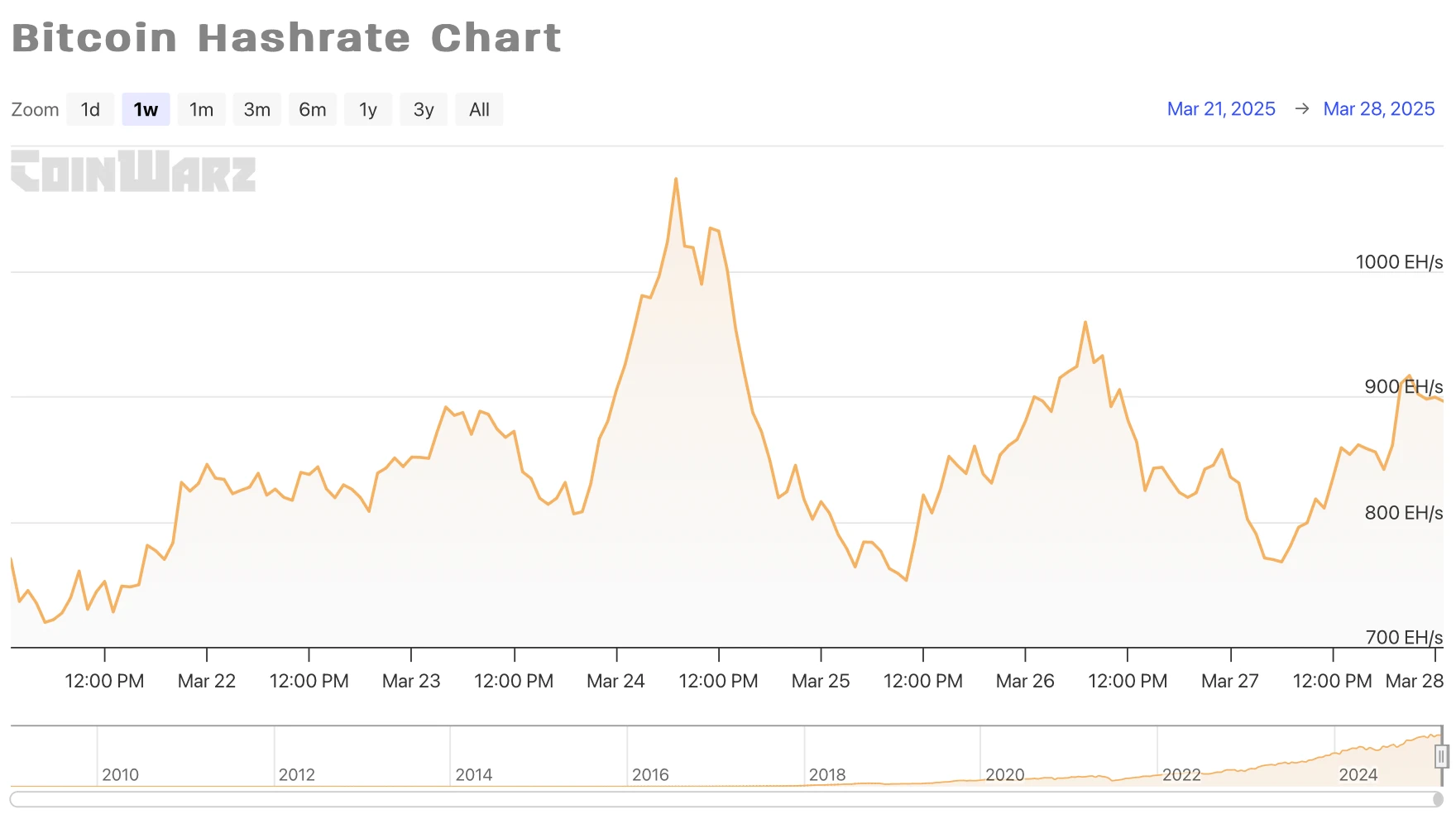
Bitcoin Network Hash Rate Data
4. Mining Revenue
According to The Block, in March 2025, the total revenue of Bitcoin miners was approximately $1.04 billion, a decrease of 16.12% from February's $1.24 billion. This decline was primarily influenced by Bitcoin price fluctuations, and due to increased competition among miners, the mining difficulty was adjusted upward by 2.88% in March, further compressing miners' profit margins.
Despite the continuous rise in mining difficulty, hash prices remained relatively stable. According to Cointelegraph data from March 23, the Bitcoin mining difficulty was adjusted upward by 1.4% at block height 889,081, reaching 1.1376 trillion, higher than the previous period's 1.121 trillion. However, the Bitcoin hash price (i.e., the average daily income per unit of computing power for miners) remained around $48 per PH/s. As of March 28, the hash price was $48.71 per PH/s, which is at a moderate level for the week.
A report from TheMinerMag pointed out that when the hash price falls below $50, miners using older machines like the Antminer S19 XP and S19 Pro may face operational pressure. Older mining machines are less efficient, and combined with declining transaction fee income, this may lead to reduced profitability for some miners, potentially forcing them to suspend operations until they upgrade to more efficient ASIC miners or the market environment improves.
Overall, the earnings of Bitcoin miners in March declined due to the dual impact of increased mining difficulty and Bitcoin price fluctuations. Although hash prices remained relatively stable, miners relying on older machines still face significant profit pressure, and the industry may see a trend of optimizing computing power or upgrading equipment. In the future, miners' profitability will continue to depend on Bitcoin price trends, transaction fee levels, and further changes in mining difficulty.
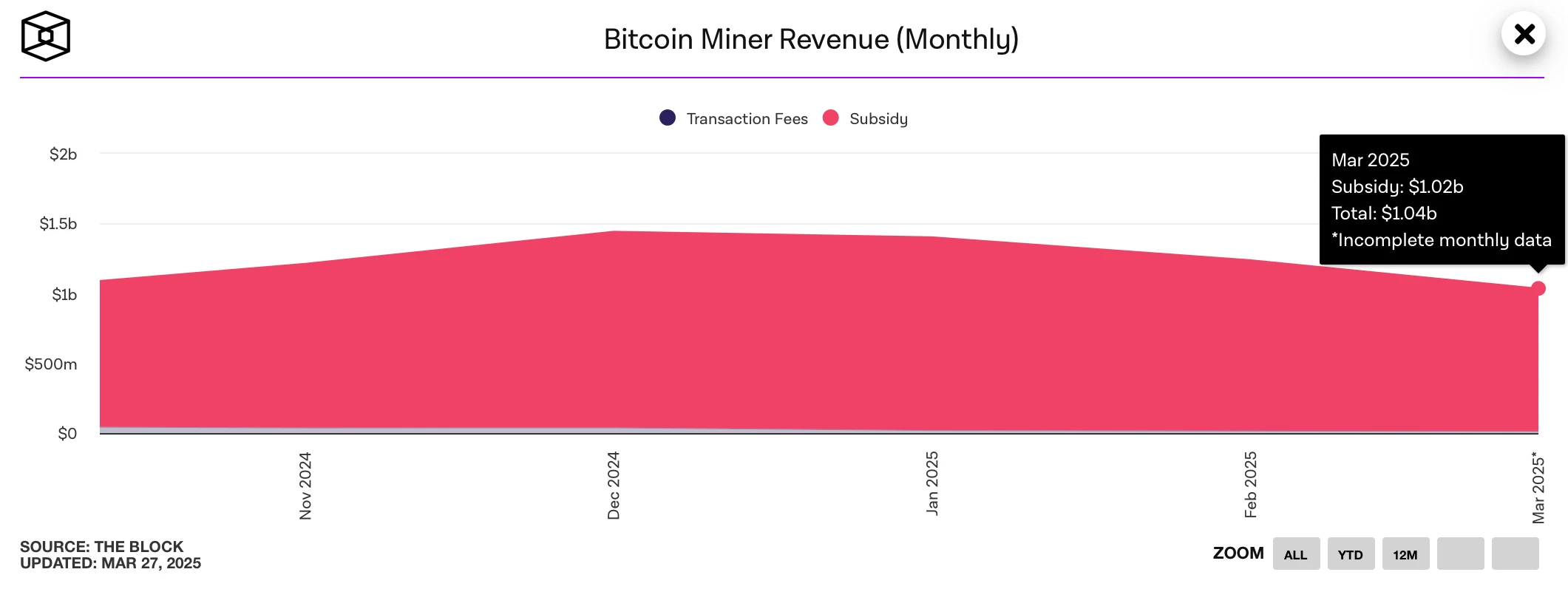
Bitcoin Miners Monthly Revenue Data
5. Energy Costs and Mining Efficiency
According to CloverPool data, as of the time of writing, the total network computing power of Bitcoin has reached approximately 855.38 EH/s, with the current mining difficulty at 113.76 T. Based on current trends, it is expected that in the next difficulty adjustment (approximately 8 days later), Bitcoin mining difficulty will be further increased by about 0.72%, reaching 114.57 T. An increase in difficulty means that the number of Bitcoins mined per unit of computing power decreases, which in turn affects miners' yield and energy efficiency. Meanwhile, with the continuous upgrade of mining equipment, overall mining efficiency is optimized, and some miners may choose more energy-efficient ASIC miners to reduce the energy cost per unit of computing power.
According to the latest data from MacroMicro, on March 26, 2025, the total production cost of Bitcoin was approximately $85,204.87, while the Mining Cost-to-Price Ratio was 0.98. This ratio is close to 1, indicating that the current market price (around $86,000) is roughly equal to the mining cost, meaning miners' profit margins are being squeezed. When this ratio approaches or exceeds 1, some miners with higher operational costs may face the risk of losses, especially individuals or small mining farms relying on lower-efficiency mining machines.
In this context, miners' strategic adjustments become crucial. On one hand, some mining farms may choose to optimize electricity procurement costs by relocating to areas with lower electricity prices or adopting renewable energy to reduce operational costs. On the other hand, miners may accelerate hardware upgrades, using more efficient ASIC miners to maintain profitability in an increasingly competitive environment. Additionally, if Bitcoin prices rise further, even if mining costs trend high, miners' profitability is still expected to be maintained. However, if prices experience a significant pullback, some high-cost miners may face pressure to shut down machines or adjust their operational models.
In summary, the profitability of Bitcoin mining is at a critical juncture, with dynamic changes in market prices, mining difficulty, and electricity costs directly determining miners' survival space and the overall computing power layout of the industry. In the future, with market fluctuations and difficulty adjustments, the mining industry may usher in a new round of computing power restructuring and industrial upgrades.
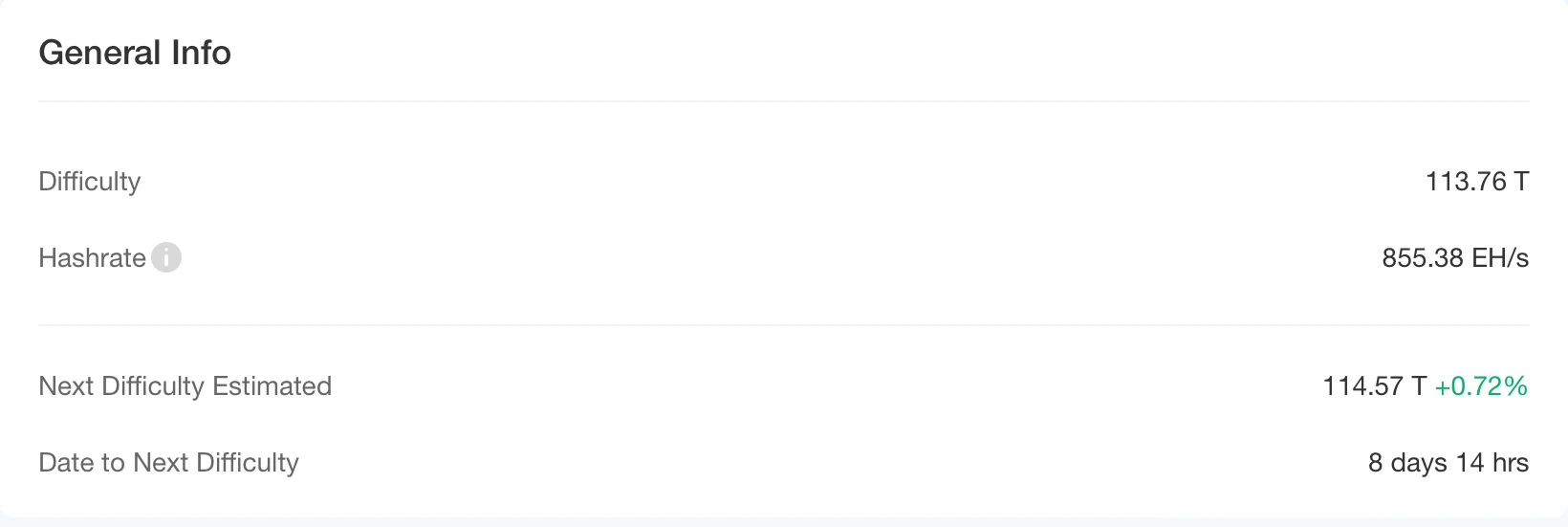
Bitcoin Mining Difficulty Data
6. Policy and Regulatory News
Acceleration of Bitcoin Legislation in U.S. States, Multiple States Promote Reserve and Self-Custody Rights Protection
Kentucky officially signs the "Bitcoin Rights Bill" — On March 24, 2024, the Governor of Kentucky officially signed HB701, which guarantees residents' rights to use self-custody wallets and run blockchain nodes, clarifying that such activities are not subject to money transmission licensing and securities regulation, while restricting local governments from discriminatory management of related technological activities.
Oklahoma House passes strategic Bitcoin reserve bill — On March 25, 2024, the Oklahoma House voted to pass a strategic Bitcoin reserve bill, allowing the state to invest 10% of public funds in Bitcoin or digital assets with a market cap exceeding $500 billion, aimed at enhancing the diversity and long-term return potential of state government fund reserves.
North Carolina Bitcoin investment bill will create an investment management agency to promote 5% fund investment in digital assets — On March 25, 2024, Bitcoin Laws disclosed details of North Carolina's Bitcoin investment bill. The state House bill HB506 will create the North Carolina Investment Management Agency (NCIA), led by the state treasurer, and authorize the agency to invest 5% of state funds in digital assets. The HB506 bill does not actually create a "Bitcoin reserve," and its concept is similar to Florida's HB487 and SB550, which allow state-level public funds to invest in Bitcoin but do not mandate holding.
South Carolina Bitcoin reserve bill will allow deployment of 10% of state funds to invest in Bitcoin, capped at 1 million BTC — On March 28, news from Bitcoin Laws stated that the South Carolina Bitcoin reserve bill (H4256) will allow the state treasurer to invest 10% of state funds in Bitcoin, with a cap of 1 million BTC. This bill was proposed by Representative Jordan Pace.
26 states have introduced Bitcoin reserve bills, accounting for over 50% — As of March 26, 2024, 26 states in the U.S. have introduced Bitcoin reserve bills, meaning that more than half of the states in the U.S. are considering Bitcoin as part of government asset allocation, with some states proposing to allocate up to 10% of state funds to crypto assets. Additionally, Wisconsin has become the first state to purchase a Bitcoin ETF, holding $588 million as of the fourth quarter of 2024.
These legislative developments indicate that multiple states in the U.S. are actively promoting the legalization of Bitcoin and providing clearer legal protections for government fund allocation and residents' usage rights.
7. Mining News
Bernstein Downgrades Target Prices for Several Listed Bitcoin Mining Companies, Maintains BTC Year-End Target Price of $200,000
On March 20, news emerged that brokerage firm Bernstein downgraded target prices for several listed Bitcoin mining companies, including IREN, CleanSpark, and Riot Platforms, as these companies' stock prices have significantly underperformed BTC so far this year. Analyst Gautam Chhugani explained that Bitcoin mining companies have experienced painful adjustments this year, with declines of 20-40%, while Bitcoin has dropped by 10%. Overall, the price trends of listed mining companies have been disappointing, with no significant increases in the fourth quarter of last year, and their performance this year has been worse than Bitcoin's adjustments.
However, Bernstein analysts maintained their year-end target price for Bitcoin at $200,000.
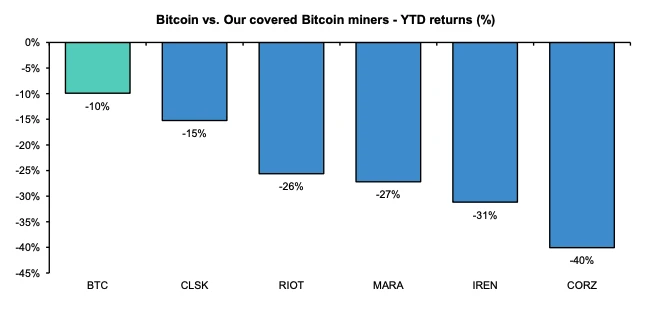
Related Images
Pakistan Proposes to Use Surplus Energy for Bitcoin Mining
On March 24, news emerged that Pakistan proposed to utilize its surplus energy for Bitcoin mining, marking a significant shift from its previous anti-cryptocurrency stance. This proposal was put forward by Bilal Bin Saqib, CEO of the newly established Crypto Council, during the first meeting on March 21, 2025. The meeting included high-level participants such as lawmakers and the Governor of the State Bank of Pakistan. The plan aims to establish a robust crypto ecosystem in Pakistan, attract foreign investment, and position the country as a major cryptocurrency hub. This change comes after the government previously opposed cryptocurrencies under the influence of global pro-crypto policies from the Trump administration. The proposal aligns with international trends, embracing digital assets and signaling a new chapter for Pakistan in the digital age.
Microsoft Cuts Data Center Plans, Shares of Bitcoin Mining Companies Like Bitfarms Drop
On March 27, news emerged that Microsoft canceled investments in some data centers in the U.S. and Europe due to concerns about an oversupply of AI computing power, leading to a 4%-12% drop in the stock prices of several crypto mining companies, including Bitfarms, CleanSpark, and Marathon. Analysts noted that this move exacerbates mining companies' reliance on AI business, while the decline in Bitcoin's halving-related earnings has already put pressure on the industry. Microsoft plans to focus on upgrading existing center equipment, with further expansion expected to slow down in the second half of 2025.
8. Bitcoin News
Global Corporate and National Bitcoin Holdings (Weekly Statistics)
Hong Kong Asia Holdings: On March 20, Hong Kong Asia Holdings (01723.HK) purchased 10 Bitcoins for a total price of 6.6712 million HKD (approximately 858,500 USD). The company currently holds a total of 18.88 BTC, valued at approximately 1.72 million USD.
Metaplanet: On March 25, Metaplanet added 150 Bitcoins to its holdings for a total of approximately 1.886 billion JPY. As of now, the company holds a total of 3,350 BTC, with a total purchase amount of approximately 42.216 billion JPY.
KULR: On March 25, the U.S.-listed company KULR increased its holdings by 56.3 BTC at a price of 88,824 USD per coin, bringing its total holdings to 668.3 BTC, with a total purchase amount of approximately 65 million USD and an average holding cost of 97,305 USD per coin.
Fidelity: On March 25, Fidelity increased its holdings by 688.547 BTC through its Bitcoin ETF (FBTC), with a total value of approximately 60.2 million USD.
The Blockchain Group: On March 27, the French tech consulting company The Blockchain Group purchased 580 Bitcoins at a price of approximately 81,550 EUR (about 87,874 USD) each. After this transaction, the company's total Bitcoin holdings reached 620 BTC, valued at over 54.2 million USD at current market prices, making it the 28th largest corporate holder of Bitcoin globally.
KULR: On March 25, the U.S.-listed company KULR increased its holdings by 56.3 BTC at a price of 88,824 USD per coin, bringing its total holdings to 668.3 BTC, with a total purchase amount of approximately 65 million USD and an average holding cost of 97,305 USD per coin.
IMF Includes Bitcoin and Other Digital Assets in Global Economic Reporting Framework for the First Time
On March 23, the International Monetary Fund (IMF) released the seventh edition of the "Balance of Payments Manual" (BPM7) on March 20, which for the first time includes cryptocurrencies and other digital assets in the global economic reporting framework, marking the first update to the manual since 2009. According to the new framework, digital assets are categorized into fungible tokens and non-fungible tokens, and further classified based on whether they carry related liabilities:
- Assets like Bitcoin, which are unbacked, are classified as non-productive non-financial assets and fall under the capital account;
- Digital currencies like stablecoins that are backed by liabilities are considered financial instruments;
- Platform tokens like ETH and SOL, if held cross-border, may be classified as equity-like instruments;
- Staking and cryptocurrency yield activities are regarded as sources of dividend income;
- Mining and staking-related services are recognized as exportable computer services. (CrowFund Insider)
The IMF plans to promote the widespread adoption of BPM7 and the latest national accounts system by 2029-2030.
White House Official: U.S. May Use Its Gold Reserves to Purchase More Bitcoin
On March 24, Bo Hines, executive director of the President's Advisory Council on Digital Assets, stated in an interview that the U.S. could use the proceeds from its gold reserves to purchase more Bitcoin. According to Hines, this move could be a budget-neutral way to increase the country's Bitcoin reserves. Hines referenced the Bitcoin bill proposed by Senator Cynthia Lummis, which advocates for the U.S. to acquire 1 million Bitcoins within five years, approximately 5% of the total Bitcoin supply. The purchase of Bitcoin would be funded by selling the Federal Reserve's gold certificates.
Author of "Rich Dad Poor Dad": Fear of Making Mistakes Causes the Poor to Miss Wealth Opportunities, Missing Bitcoin May Be the Biggest Regret
On March 24, Robert Kiyosaki, author of "Rich Dad Poor Dad," posted on the X platform that Bitcoin presents a historic wealth opportunity, but many people miss out due to FOMM (Fear of Making Mistakes). He believes that FOMO investors will accumulate generational wealth, while the FOMM crowd will only lament "too expensive" after Bitcoin breaks 200,000 USD.
Bitcoin supporters like Jeff Booth, Michael Saylor, and Samson Mow are optimistic about Bitcoin's wealth effect in the long term, while the traditional education system instills fear of failure in many, ultimately causing them to miss opportunities.
Arthur Hayes: Predicts Bitcoin Will Break 110,000 Before Retesting 76,500
On March 24, BitMEX co-founder Arthur Hayes posted on the X platform, predicting that Bitcoin will break 110,000 before retesting 76,500, reasoning that the Federal Reserve is shifting from quantitative tightening (QT) to implementing quantitative easing (QE) for government bonds, and tariffs are no longer important because "inflation is temporary," as stated by Jay Powell. He indicated that he would elaborate on this viewpoint in his next article.
Standard Chartered: Bitcoin Offers Higher Returns and Lower Volatility Than Tesla
On March 25, Standard Chartered constructed a hypothetical index "Mag 7B," replacing Tesla with Bitcoin, and found that it offers higher returns and lower volatility. Bitcoin has a high correlation with the Nasdaq and may become part of a tech stock portfolio. Since December 2017, Mag 7B has outperformed Mag 7 by 5%, and over the past 7 years, Mag 7B's average annual return has been 1% higher. The inclusion of Bitcoin reduces portfolio volatility and increases the information ratio. As Bitcoin trading becomes more convenient, it is expected to attract more institutional funds.
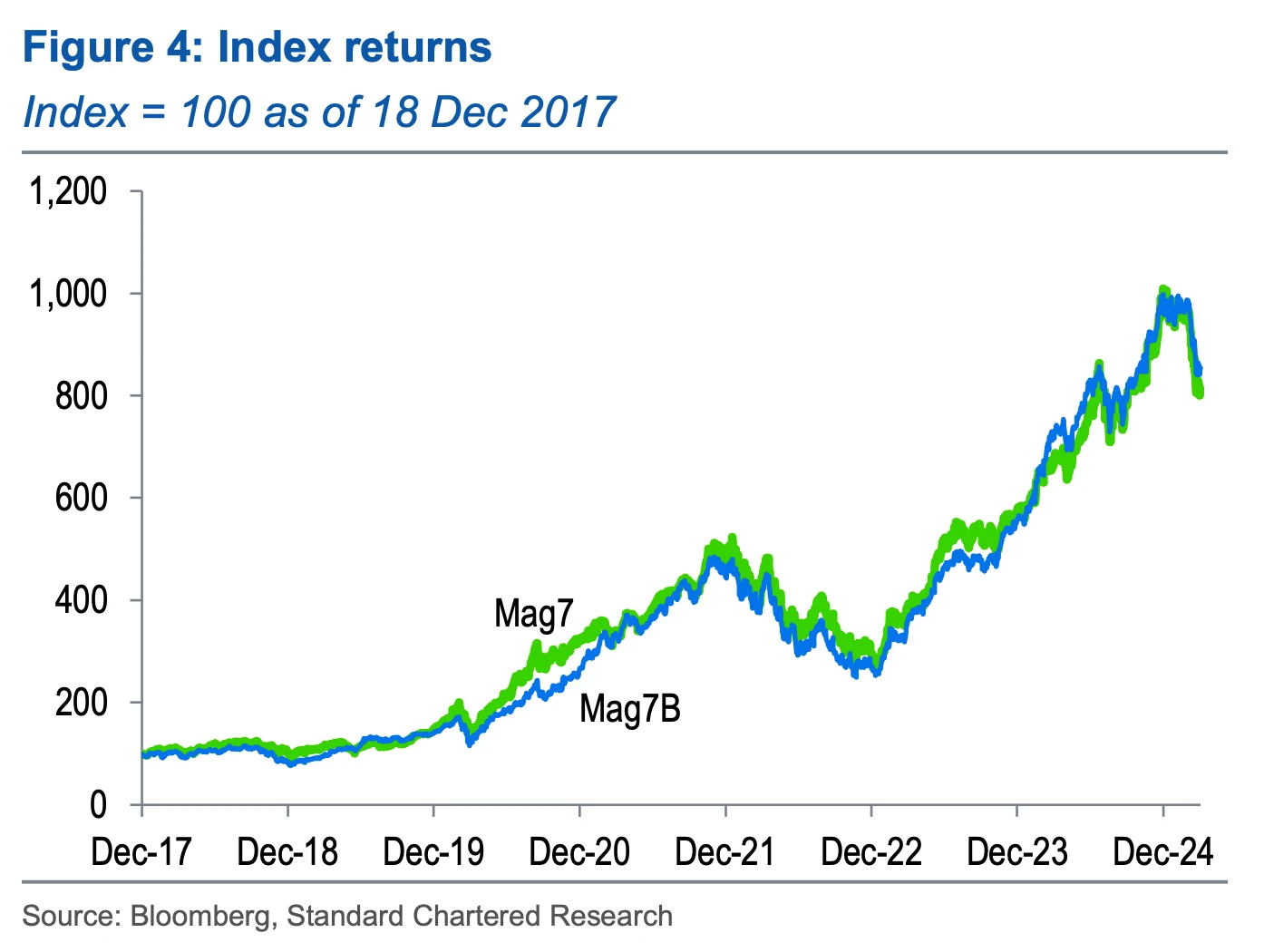
Related Images
Michael Saylor Expects BTC to Become a $200 Trillion Asset Class and Global Settlement Layer
On March 25, Strategy founder Michael Saylor predicted that by 2024, BTC will become a $200 trillion asset class and serve as the global settlement layer in the AI-driven internet era. The U.S. adopting Bitcoin as a strategic reserve will solidify its dominance and compel global adoption. Strategy has accumulated over 500,000 Bitcoins using innovative financial instruments like convertible bonds and preferred stock, raising funds for its corporate Bitcoin treasury while financially designing a self-sustaining price appreciation cycle.
Michael Saylor has stated that he will destroy BTC before his death rather than donate these assets, as this approach is a more ethical and rational form of charity that will grant Bitcoin "economic immortality," allowing everyone in the Bitcoin network to become wealthier and more powerful.
T. Rowe Price Executive Says Now is an "Excellent Time" to Allocate Bitcoin
On March 26, according to CoinDesk, Dominic Rizzo, global technology portfolio manager at T. Rowe Price, which manages over $1 trillion in assets, stated at the Exchange conference in Las Vegas that Bitcoin's price is currently close to the average mining cost, making it an attractive allocation point. He also suggested that investors could indirectly allocate to digital assets through stocks or blockchain-related companies like Coinbase and Robinhood.
Bitwise CIO: Now is the Best Time in History to Buy Bitcoin at Risk-Adjusted Prices
On March 27, Bitwise Chief Investment Officer Matt Hougan stated that now is the best time in history to acquire Bitcoin at risk-adjusted prices, as nearly all survival threats (including regulatory ones) have been eliminated. With the U.S. establishing a strategic Bitcoin reserve, Hougan believes the last major risk has shifted to long-term validation.
PlanB: Bitcoin is Severely Undervalued Compared to Gold and Real Estate Markets
On March 28, analyst PlanB posted on the X platform that "Bitcoin appears extremely undervalued compared to gold and real estate markets. Currently, Bitcoin's market cap is $2 trillion, while gold's market cap is as high as $20 trillion. Additionally, Bitcoin's scarcity (S2F ratio) reaches 120 years, far exceeding gold's 60 years. Let's wait and see what changes this halving cycle will bring."
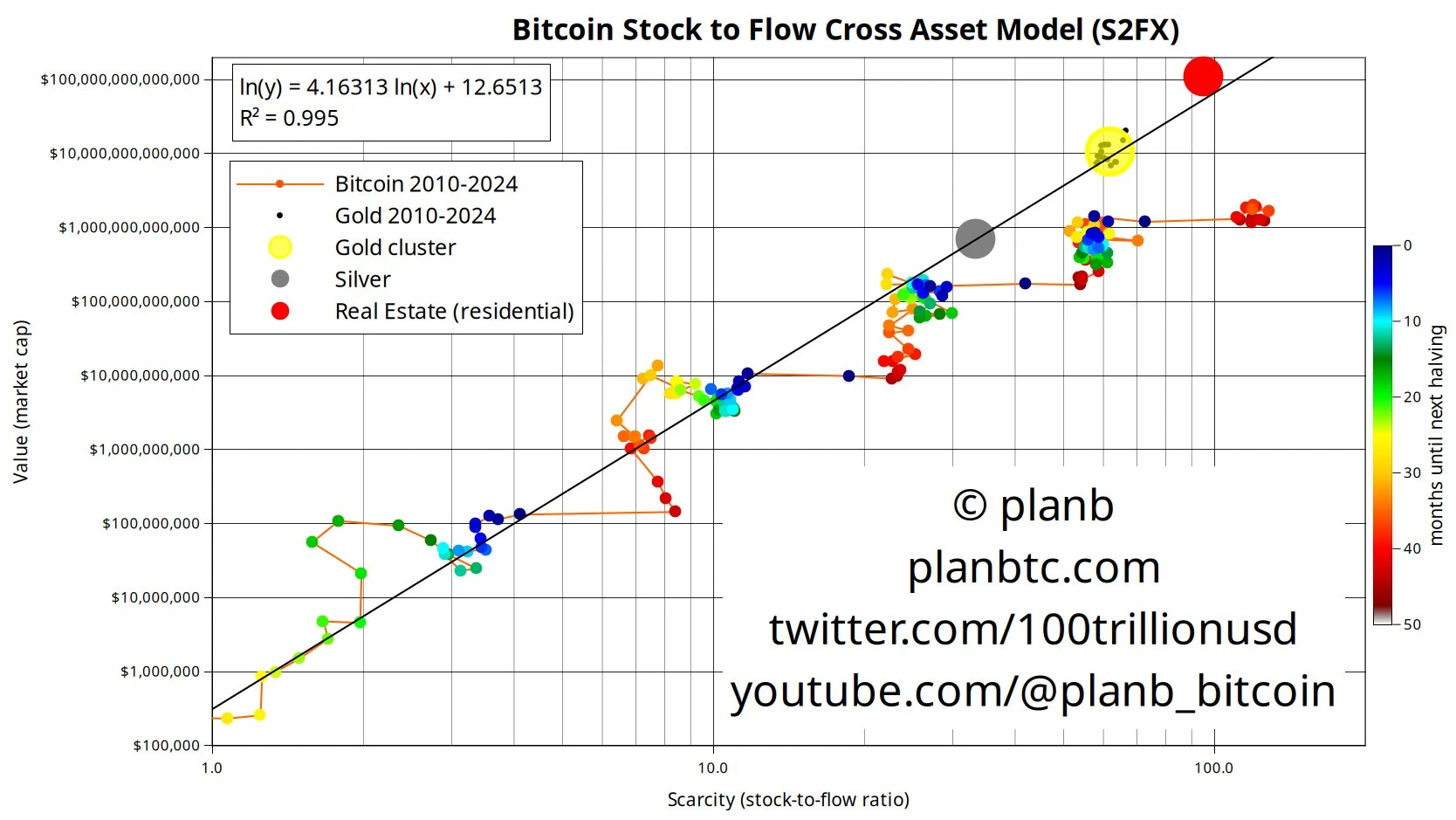
Related Images
免责声明:本文章仅代表作者个人观点,不代表本平台的立场和观点。本文章仅供信息分享,不构成对任何人的任何投资建议。用户与作者之间的任何争议,与本平台无关。如网页中刊载的文章或图片涉及侵权,请提供相关的权利证明和身份证明发送邮件到support@aicoin.com,本平台相关工作人员将会进行核查。




